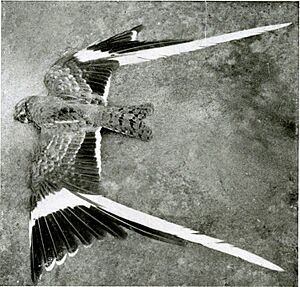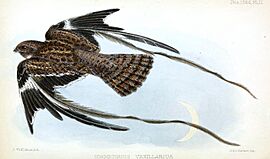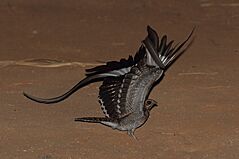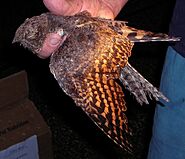Pennant-winged nightjar facts for kids
Quick facts for kids Pennant-winged nightjar |
|
|---|---|
 |
|
| Young breeding male | |
 |
|
| Female | |
| Conservation status | |
| Scientific classification | |
| Genus: |
Caprimulgus
|
| Species: |
vexillarius
|
| Synonyms | |
|
|
The pennant-winged nightjar (Caprimulgus vexillarius) is a special type of nightjar, a bird known for being active at dawn and dusk. These birds live in Africa, from Nigeria all the way down to northern South Africa. They are amazing travelers, flying long distances across Africa during different seasons. What's really cool about them is how different the males and females look, especially when it's time to have babies!
Contents
Where Pennant-winged Nightjars Live
These birds love to live in certain types of forests, especially those found on high, flat lands south of the equator. They particularly like areas with lots of trees called Miombo woodlands, often choosing rocky or stony hillsides.
You can see them flying through places like the Kenyan Rift Valley and near Lake Victoria twice a year as they travel. When it's not their breeding season, they fly north and spend time in warm, grassy areas called savannas, stretching from Nigeria to Sudan.
What Pennant-winged Nightjars Look Like
Male pennant-winged nightjars are easy to spot because of their unique wings. They have a wide white stripe across their mostly black flight feathers. But the most amazing part is a super long feather that grows on each wing during the breeding season! These special feathers, called "pennants," get longer each year. They can even grow to be twice as long as the bird's body! After the breeding season, these long feathers usually fall off or break. Because of these long feathers, the wings of the male birds look very angular and distinct.
Daily Life and Habits
Pennant-winged nightjars are most active during twilight, which is the time just after sunset or right before sunrise. This is when they hunt for food. Their favorite foods are different kinds of insects, especially scarab beetles. They are also very clever when they drink water; they fly slowly over the surface of the water and scoop it up!
These birds usually rest and build their nests right on the ground, sometimes hidden among fallen leaves. If something disturbs them, they might perch lengthwise on a tree branch. This helps them blend in, just like the European nightjar, which is a similar size.
Reproduction and Breeding
Pennant-winged nightjars start their breeding season in spring and early summer when they are in the southern parts of Africa. Each male bird has its own special area where it tries to attract females. They sing an insect-like song to call out to them.
Males also perform amazing display flights. They fly low through the trees or very high up in the sky. Sometimes, females who are ready to breed will join them in these flights. The female birds usually lay their eggs around the time of the full moon. By the middle of summer, some of these birds begin their long journey back to the northern parts of Africa.
Gallery






